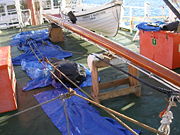
Worm, parcel and serve
Encyclopedia

Rope
A rope is a length of fibres, twisted or braided together to improve strength for pulling and connecting. It has tensile strength but is too flexible to provide compressive strength...
is to apply a multi-layered protection against chafe and deterioration. It is a technique not usually used on modern small boats, but is found extensively on traditionally-rigged sailing ships. Worming, parcelling and serving can be applied only to traditional twisted rope, not the braided line almost exclusively used on modern vessels.
Worming
"Worming" the line is designed to fill in the channels between the strands (the cuntlines) in order to keep water out and to allow tighter wrapping of the next layers by giving the rope a more cylindrical shape. Three lengths of "small stuff" or string are led along the lay of the rope between the strands, following the twist so that they spiral round the main line.Parcelling
The line is then "parcelled" by wrapping it in a spiral fashion with long overlapping strips of thin canvas. This is wound from bottom to top to prevent water from running in - in the same direction as the worming. The rule is "worm and parcel with the lay; turn and serve the other way".Serving
The outer layer of protection is formed of twine wrapped as tightly as possible around the line, covering it completely. Following the rhyme above, it should of course run against the lay of the rope; this alternation helps prevent sideways chafe from opening up the protection. A serving mallet can be used to help get the outer twine as tight as possible - despite the name (arising from its shape) the serving mallet is not used to hit anything; it forms a kind of guide and tensioning lever for applying the twine to the rope.Tar
An optional final stage for the permanent protection of rope is to paint the outer layer of twine with a mixture of tar, varnish and black paint. This needs renewing periodically, and going aloft to paint footropeFootrope
Each yard on a square rigged sailing ship is equipped with a footrope for sailors to stand on while setting or stowing the sails.Formerly, the footrope was the rope sewn along the lower edge of a square sail, and the rope below the yards was called the horse or Flemish horse...
s and stays
Stays (nautical)
Stays are the heavy ropes, wires, or rods on sailing vessels that run from the masts to the hull, usually fore-and-aft along the centerline of the vessel...
is one of the regular maintenance tasks on many tall ship
Tall ship
A tall ship is a large, traditionally-rigged sailing vessel. Popular modern tall ship rigs include topsail schooners, brigantines, brigs and barques. "Tall Ship" can also be defined more specifically by an organization, such as for a race or festival....
s.
An alternative opinion from someone who does the job: The tar, or "slush" is a mixture of Stockholm tar, boiled linseed oil, and Japan drier. The term "slush" is also used to describe the grease applied to the masts to lubricate the parrels so that the yards can raise and lower freely.

